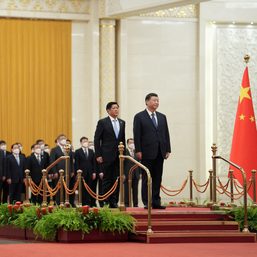SUMMARY
This is AI generated summarization, which may have errors. For context, always refer to the full article.
![[OPINION] Grayzone tactics: A maritime insurgency in the South China Sea?](https://www.rappler.com/tachyon/2023/03/grayzone-tactics-march-2-2023.jpg)
Grayzone operations is integral to the Chinese Communist Party’s maritime strategy in the South China Sea; and it continues to defy any political, naval, or legal solution. Former Associate Chief Justice Antonio Carpio’s points at the risk, if this remains unaddressed:
“ At stake is the survival of the legal order enshrined in the 1945 UN Charter, that no state shall use armed force to settle a dispute with another state but must use only peaceful means to settle such dispute…. [We]must prevent China from overturning this fundamental principle, [otherwise], we will go back to the ‘might is right’ order that prevailed before.”
Hunter Stires of the US Naval War College, depicts grayzone tactics as a “maritime insurgency,” involving:
“[a] campaign to undermine and ultimately overturn the prevailing regime of international law that governs the conduct of maritime activity in the South China Sea. [It…] is a ‘battle of legal regimes,’ a political contest of wills that manifests itself in a duel between two competing systems of authority—the U.S.-underwritten system of the free sea, versus the Chinese vision of a closed, Sinocentric, and unfree sea.”
Revisiting David Galula’s scholarly work, entitled “Counterinsurgency Warfare: Theory and Practice,” an insurgency is:
“…a protracted struggle conducted methodically, step by step, in order to attain specific intermediate objectives leading to the overthrow of the existing order.”
Given this, Xi Jinping’s “China Dream” emerges as a “global insurgency” with an ambiguous end-goal; waged now, but culminating in 2049 during the CCP’s 100th anniversary. Xi’s various policies and programs, would likely be synchronized through his Global Development Initiative, and Global Security Initiative. Galula further posits on the dynamics between “insurgents” and “counterinsurgents” (in our case referring to the CCP and like-minded democracies):
“…[promoting] disorder is the legitimate objective of the insurgents. It helps to disrupt the economy, …to produce discontent; …undermine the strength and authority of the counterinsurgents. [It] is cheap to create, and hard to prevent.”
Towards this end, China arose from the post-Nixon years as the global supply chain’s hub, established the Asian Infrastructure Investment Bank, entrenched itself in the United Nations, infiltrated the digital world through TikTok, and, lobbied for the adoption of Huawei’s 5G network. All these were to supplant the West’s influence in the geo-political arena; the global economy; among international institutions; in space, cyber, and technology; and, in the cognitive domain. Galula further warned that:
“[once]the insurgents has succeeded in acquiring geographical bases, he becomes ipso facto a strong promoter of order within his own area, in order to show the difference between the effectiveness of his rule and the inadequacy of his opponents.”
He was prescient. In the South China Sea, it has eight occupied isles and features within the Spratly’s Island Group, and maintains bases in Hainan and the Paracels. It enabled its navy, coast guard, and fisheries militia to coerce adjacent coastal states, including the Philippines, using its domestic laws to justify encroachment within our EEZ.
The CCP desires the acquiescence of Southeast Asia as modern day tributary-states. Over time, it successfully drove a wedge among ASEAN member-states, employed influence operations to coopt the its political and economic elites, and tried to use the ASEAN-China Code of Conduct negotiations to oust the US from the region. Galula warned of the impact on the “people”(referring to Southeast Asia):
“… [if] the insurgents manages to disassociate people from counterinsurgents, to control it physically, to get its active support, he will win the war because, in the final analysis, the exercise of political power depends on the tacit or explicit agreement of the population, or at worst, on its submissiveness.”
The tendency to hedge relations with the US and China, underscores the efficacy of the latter’s sharp power in compelling ASEAN to submit. In our case, Duterte’s “appeasement policy” allowed China to challenge the exercise of sovereignty and sovereign rights within our own waters. However, this will not convert Southeast Asia into “firm believers” of Xi’ dream. Galula elucidates:
“The first basic need for an insurgent is an attractive cause, [in which]the insurgents has a formidable, if intangible, asset that he can progressively transform into a concrete strength..”
Here lies the dream’s weakness: its benefits China exclusively, no “rallying cause” for Southeast Asia, and living in a “surveillance state” holds no attraction at all. Xi’s insurgency has a flaw, and it can be overcome if the region works together. – Rappler.com
Rear Admiral Rommel Jude Ong (Ret.) is currently Professor of Praxis at Ateneo School of Government. He was formerly the Vice Commander of the Philippine Navy.
Add a comment
How does this make you feel?




There are no comments yet. Add your comment to start the conversation.